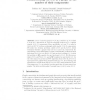Free Online Productivity Tools
i2Speak
i2Symbol
i2OCR
iTex2Img
iWeb2Print
iWeb2Shot
i2Type
iPdf2Split
iPdf2Merge
i2Bopomofo
i2Arabic
i2Style
i2Image
i2PDF
iLatex2Rtf
Sci2ools
ISAAC
2009
Springer
2009
Springer
Parameterizing Cut Sets in a Graph by the Number of Their Components
For a connected graph G = (V, E), a subset U ⊆ V is called a k-cut if U disconnects G, and the subgraph induced by U contains exactly k (≥ 1) components. More specifically, a k-cut U is called a (k, ℓ)-cut if V \U induces a subgraph with exactly ℓ (≥ 2) components. We study two decision problems, called k-Cut and (k, ℓ)-Cut, which determine whether a graph G has a k-cut or (k, ℓ)-cut, respectively. By pinpointing a close relationship to graph contractibility problems we first show that (k, ℓ)-Cut is in P for k = 1 and any fixed constant ℓ ≥ 2, while the problem is NP-complete for any fixed pair k, ℓ ≥ 2. We then prove that k-Cut is in P for k = 1, and is NP-complete for any fixed k ≥ 2. On the other hand, we present an FPT algorithm that solves (k, ℓ)-Cut on apex-minor-free graphs when parameterized by k + ℓ. By modifying this algorithm we can also show that k-Cut is in FPT (with parameter k) and Disconnected Cut is solvable in polynomial time for ape...
Related Content
| Added | 25 Jul 2010 |
| Updated | 25 Jul 2010 |
| Type | Conference |
| Year | 2009 |
| Where | ISAAC |
| Authors | Takehiro Ito, Marcin Kaminski, Daniël Paulusma, Dimitrios M. Thilikos |
Comments (0)

